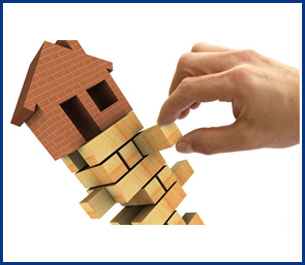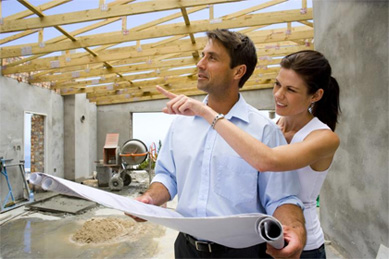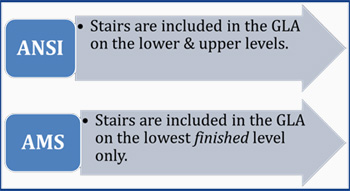The American Measurement Standard®
Institute of Housing Technologies Used by real estate professionals around the world…
You know the ANSI® name – What do you know about the AMS®? How much do you really know about either standard?
While the vast majority of professionals recognize the ANSI measurement standard, they are often surprised to learn they actually measure homes following the AMS. Few practitioners truly understand all the rules and/or requirements of following the ANSI standard. Over half of all practitioners follow the rules of the American Measurement Standard, yet they frequently claim to follow the rules of ANSI.

Both of these measurement methods are accepted in the marketplace (by FHA, VA, HUD, Fannie Mae, Freddie Mac). They are both used every day, all across the country. However, the ANSI name is used over 90% of the time. It is used, so often incorrectly, simply because they do not know the difference. It is not taught in any pre-licensing courses and is just now beginning to make its way through continuing education courses. It is also something you DO NOT want to learn about, after a lawsuit has been filed. Square footage lawsuits have been filed, appealed, and settled, and it’s just a matter of time before agents and appraisers will have to learn the difference in these two measurement standards. It’s perfectly fine to use either one (at least for now). The key is knowing which one you use and disclosing the method that you follow.

Creating residential square footage is an art and not a science. It is an extremely complex issue and no one measurement standard will work in every scenario. The commercial real estate industry embraces seven measurement “standards.” The residential side of the industry is still struggling with two. Although these two “standards” have been used by professionals for over a hundred years, the only name most people have ever heard of is the ANSI® standard. ANSI is an excellent reference guide and, when used in its entirety, provides consistent and recreatable measurements. But, for many real estate professionals, they have been taught to measure stairs (and the sloped spaces below) by a different method. Both of these methods provide acceptable measurements for use in appraisals and mortgage lending. The AMS® (American Measurement Standard) was created for the group of professionals who do NOT measure stairs by the procedures prescribed in the ANSI Guideline, but still need the protection of following a formal, definable, and defensible if necessary, Standard of Practice.
The AMS allows practitioners to say with authority “this is how I measured the house.” It provides experts with more than four times more details on measuring square footage. In the event of any square footage discrepancy, this document offers them the liability protection they need and should be afforded within their industry. Just because they do not adhere completely to the rules of ANSI does not mean they are not just as professional as those who do follow ANSI. It is simply a difference of philosophy that is common throughout the industry, much like the difference in philosophies that brought about the need for seven commercial measurement standards.
The main discrepancy in measurement methods has always centered around the measurement and calculation of stairs, the sloped areas beneath, and the measurement of upper level living areas (sloped ceilings). The measurement methods contained in the AMS are currently practiced by professional real estate agents, appraisers, and numerous industry leading home builders and architects (i.e., Centex Homes®, Donald Gardner Architects, Inc.®, and by many nationally renowned designers featured on sites such as eplans.com®, etc.).
The AMS and its associated principles provide acceptable measurements for the FHA, VA, HUD, Fannie Mae and Freddie Mac. It is more a standard, not because a particular group or organization has endorsed or adopted its use, but because it is commonly practiced throughout the industry and accepted as a common method of calculating the square footage in single-family homes. ANSI offers apx. five pages of rules and six pages of sketches. The AMS offers apx. 22 pages of rules and 37 pages of sketches.


With the continuing influx of new internet technologies, there is an ever increasing need for a consistent reporting method (or language of real estate), which can be recognized and accepted in all areas. There is currently a diverse array of titles for “living area.” Throughout the “MLS” database (and assessor’s records) practitioners will find an extensive library of titles including Heated Living Area, Finished Living Area, Heated Square Footage, Finished Square Footage, EstLivArea, Total Sq Ft, Living Area, Square Footage, Fin Space, Heated Living Space, HTD Area, Base S/F, Main Fin Area, GFLA, F/LivArea, SF, sf/Fin, etc…, making national (and some local) information searches ineffective and unreliable. In order for the real estate industry and the mortgage process to remain consistent and credible, all information created and communicated for the purposes of comparability (square footage), and that is to be utilized in the home valuation, appraisal, and/or mortgage informational systems, must be standardized for all users and consumers of residential square footage information.
Square footage provides the very foundation of value and the currency of real estate. The future of the real estate industry is dependent on the reliable, reproducible, creation and communication of this vital property data. The professional use of a written standard of practice and a written statement of square footage disclosure form helps to protect consumers and real estate practitioners. The public trusts the real estate experts and part of that trust includes providing an accurate square footage total.
The mortgage industry depends on the integrity and quality of the appraisal industry; the appraisal industry depends on the quality of information provided through the MLS; and the MLS database is completely reliant on the quality and the level of detailed information provided by the listing agent of each property transaction. The information chain, which provides the foundation of our home valuation process, is often controlled by the input of data through this one private information system (MLS). “Size” changes home values and understanding how to create (and communicate) accurate size information is critical to the stability of our national housing market.
100% Consumer Protection
You know the ANSI® name – do you follow the ANSI® method 100%? In order to claim adherence to any “standard” you must follow it completely. You cannot selectively use only the parts you like or agree with. Both of these measurement methods are accepted byFHA, VA, HUD, Fannie Mae, Freddie Mac, etc.. However, if any square footage claim is made against you, you need to be certain which “standard” you follow and disclose that fact accordingly. For your best liability protection, completely follow a formal, written, Standard of Practice. And, provide a written Statement of Square Footage disclosing the measurement standard you used in creating your square footage total. It is a smart business practice and the professional way to address the issue of square footage, protecting your client and your company.

In order to improve the quality of home valuations, the real estate industry must adopt (and mandate) one universal measurement STANDARD.
Two Measurement Standards – One Big Difference?
A space that typically measures between 30 and 50 sq ft is keeping an entire industry from standardization. Take the simple square footage quiz – one question – how do you measure stairs and the sloped spaces below. Do you know which “standard” you follow?


